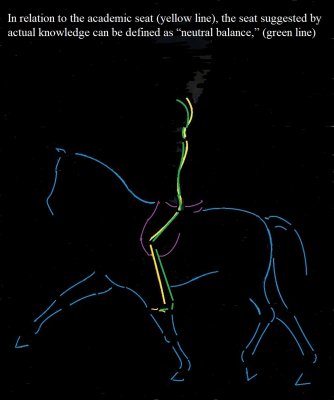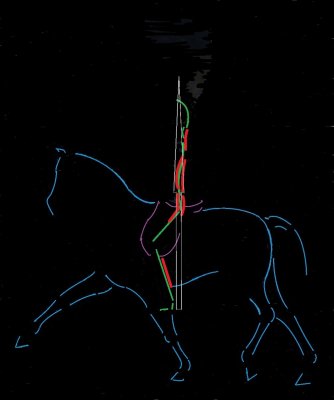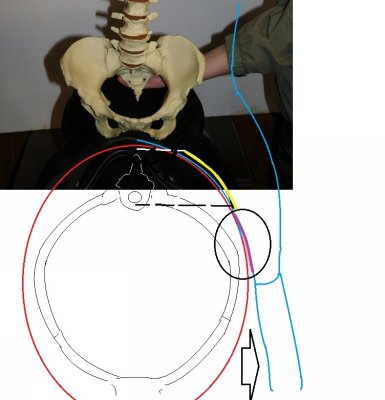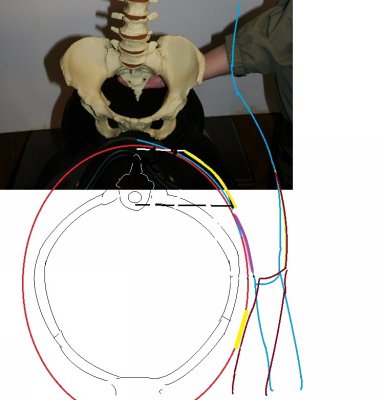Magic Portal
A Magic Portal
Jean Luc Cornille
A horse, as much as a book, is a magic portal to another dimension.
I am not talking about submission to the rider’s aids; this equitation is just a pedestal for the rider’s ego. I am talking about the dimension where the horse is willing to meet us if we raise our knowledge to his actual physiology and mental processing.
The main muscle under the rider’s legs does not engage the horse’s hind leg. The relation occurs at the level of sensors feeling leg pressure, and the memory associating the pressure with engagement of the hind leg and forward movement. However, this Pavlovian thinking is not even close to actual knowledge.  The horse’s tactile perception in the area situated under the rider leg is so high that a horse cans feel contact and pressure that are too light for the human to feel. “Using stimuli developed for gauging human tactile sensitivity, we were surprised to find that horse sensitivity on the part of the horse body which would be in contact with the rider’s leg is greater than what has been found for the adult human calf or even the more sensitive human fingertip. Horses can react to pressures that are too light for the human to feel.” (Saslow, 2002)
The horse’s tactile perception in the area situated under the rider leg is so high that a horse cans feel contact and pressure that are too light for the human to feel. “Using stimuli developed for gauging human tactile sensitivity, we were surprised to find that horse sensitivity on the part of the horse body which would be in contact with the rider’s leg is greater than what has been found for the adult human calf or even the more sensitive human fingertip. Horses can react to pressures that are too light for the human to feel.” (Saslow, 2002)
Instead of pressure, kick, or even spurs aggression, the dialogue through the legs needs to be refined to study and subtle touch. Saslow’s discovery demands a seat allowing such precision and subtlety. The classical seat, illustrated by the yellow silhouette as to be refined into the neutral seat illustrated by the green silhouette. The neutral seat, places the front part of the shoulders, the middle of the spine, the seat bone and the stirrups in on absolute vertical straight line. The neutral seat allows stable and steady contact of the upper thighs, which in turn, permits light and precise contact of the calf. The necessary precision implies light contact of the toes on the stirrup and therefore liberate the rider’s thinking and stiffness of the lower thighs caused by the infamous “heels down.”
Claiming to protect tradition and classical thinking, the ghost of theological thinking has, over generations of riders, resisted the evolution of knowledge. As the rider is in neutral balance over the seat bones and the upper thighs in study contact with the saddle, understanding that the saddle allows such contact, the heel falls naturally slightly lower than the toes. Imitating the silhouette without comprehending the dynamics involved, pretenders advise pushing the heels down, which in turn stiffens the lower part of the rider’s thigh situated above the knees, moving the calf away from study contact with the horse body.
When in study contact, the upper thighs allow influencing the horse’s thoracic spine. Instead, squeezing the lower thighs moves the calf away from the horse’s body.
Knowledge evolves, and the seat, which is how we communicate with the horse, has to evolve with knowledge. “Muscles do much more than create the forces needed to extend and flex joints, which is what has been traditionally taught in anatomy courses.  Muscles are also critical for the buffering of mechanical forces on the joints. They do this by absorbing very large amounts of energy and are thus critical to preventing overloading and to stabilization of joints. This function is so important that the energy produced by normal walking would tear all the ligaments in the knee if it were not absorbed by muscular activity.” (Elizabeth W. Uhl, DVM, Ph.D DACVP and Michelle L. Osborn, Ph.D)
Muscles are also critical for the buffering of mechanical forces on the joints. They do this by absorbing very large amounts of energy and are thus critical to preventing overloading and to stabilization of joints. This function is so important that the energy produced by normal walking would tear all the ligaments in the knee if it were not absorbed by muscular activity.” (Elizabeth W. Uhl, DVM, Ph.D DACVP and Michelle L. Osborn, Ph.D)
Most of the length change required for locomotion as well as performances, does not occurs in the muscle fibers themselves but by elastic recoil of the associated tendons and aponeurosis. The muscles ensure adequate tension of the associated tendons, and aponeurosis to maximize their elastic work and store energy for the next sequence of the stride. Fascia is also kept under tension by appropriated muscular work. The old theory of stimulus response, which is the fundamental behind the concept of obedience to the rider’s aids, does not hold well in front of the evolution of knowledge. The constant, complex, and subtle adjustments that muscles have to do in order to manage forces through associated tendon and aponeurosis, cannot be ensure by the rider’s aids whatever refined are the rider’s aids. The conversation with the horse occurs in another dimension. While at first, the horse’s willingness and capacity of complex mental processing, is a pedestal for the rider’s ego, allowing the rider to take the credit, creativity and critical thinking allows to reach the essence of the equestrian art.
The horse is a magic portal to another dimension. The horse invites us to meet him at a level of subtlety, ethic and intelligence where friendship is about two intelligences helping each other. The rider’s knowledge creating conditions such as natural cadence, body coordination, allowing the horse to process the most efficient body coordination. Instead of judging or being judged, intelligence, creativity and willingness allow both, the horse and the rider, to make mistakes and use the mistakes to guide more efficiently the horse’s mental processing toward the body coordination optimally adapted to the athletic demand of the performance. Creativity is allowing yourself, as well as the horse, to make mistakes. Art is knowing which one to keep. Jean Luc Cornille


 twitter
twitter facebook
facebook google
google pinterest
pinterest linkedin
linkedin